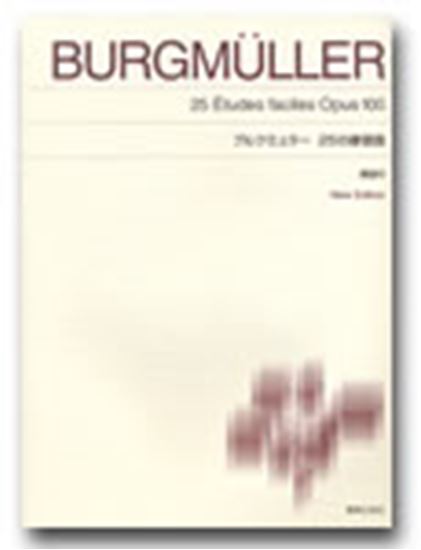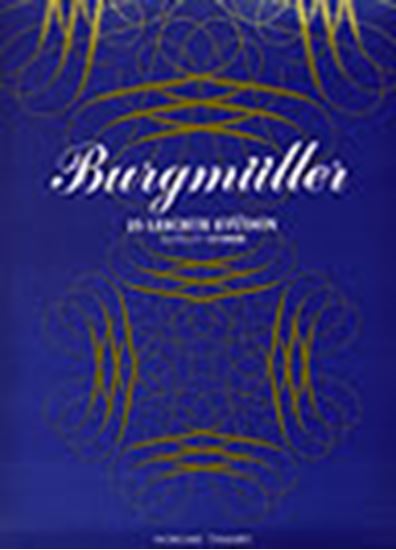Burgmüller, Johann Friedrich Franz : 25 Etudes faciles et progressives, conposées et doigtées expressément pour l'étendue des petites mains La Styrienne Op.100-14
Work Overview
Genre:etude
Total Playing Time:2 min 00 sec
Copyright:Public Domain
Additional Notes:表記ゆれの例:スティリアの女 シュタイアー舞曲 シュタイアー地方の踊り スチリアの女
Commentary (3)
Author : Sato, Takashi
Last Updated: January 31, 2022
[Open]
Author : Sato, Takashi
The title Styrienne originates from the Styria region of Austria. While it was formerly translated as "Styrian Woman," "Styrian Dance" is now the more common translation. It is a type of Ländler in 3/4 time, not as fast as a waltz, and is a dance with flexible tempo variations. When playing, imagine people in traditional costumes joyfully dancing in the Alpine mountains.
Performance Points (Original Tempo ♩=176)
In the introduction, clearly distinguish between the dotted half note with its striking appoggiatura and the subdivisions on beats 2 and 3. At measure 4, play so that the half cadence does not sound like a full cadence, feeling the resolution to the tonic (I degree) at measure 5. Play the three-eighth-note anacrusis charmingly, and at measure 8, clearly differentiate between the end of the phrase (on the downbeat of beat 2) and the beginning (from the upbeat of beat 2). The sixth-interval leaps on beats 2 and 3 of measure 23 imitate the Alpine yodeling vocal technique. Play the off-beat notes slightly softer, like a falsetto voice. In the middle section from measure 29, play the melodies "F - E" and "D - G" after the leaps carefully. The anacrusis leading to measure 35 is exceptionally legato, so try to be creative with your expression.
(To-on Edition "Burgmüller 25 Etudes" (NS70))
Author : Iida, Arisa
Last Updated: March 15, 2018
[Open]
Author : Iida, Arisa
Musical example provided by: Ongaku no Tomo Sha
Author : Ooi, Kazurou
Last Updated: May 10, 2019
[Open]
Author : Ooi, Kazurou
1. On Articulation
2. On Tempo Rubato
This piece is marked with a quarter note at 176. This tempo is generally appropriate, and a slightly faster tempo might also be effective. However, if the tempo is too slow or the articulation lacks crispness, the inherent joy of the piece may not be conveyed to the listener. The primary hint for performing this piece is to make it sound enjoyable.
To achieve this, first, ensure that the right-hand staccato notes are played short and light, avoiding any heaviness. Although staccato marks are not written for the left-hand accompaniment, there are eighth rests present. It is advisable to play the left hand also lightly and with a short, detached touch.
A common pitfall for performers is to play too rigidly, akin to a metronome. This piece requires a certain degree of rubato. It is a piece that benefits from free stretching and pulling of the tempo, rather than a strictly uniform and unvarying pace. This is a crucial point.
The technically challenging sections for the performer lie in the right-hand leaps in measures 29, 31, and 33. Begin by practicing only from the first beat to the second beat. Let's take measure 29 as an example: the right hand leaps from F on the first beat to a high D. Practice only this segment (between the 1st and 2nd beats). When doing so, always practice with the left hand. This is because the position of the left hand can help the right hand remember its position. Similarly, the left hand can rely on the right hand, allowing both hands to learn their positions by relying on each other.
First, after playing the right-hand F, leap to D. At this point, practice several times by merely placing your finger on the key D without actually playing it. Play F, but do not play D; however, your finger must land on it. After playing F, quickly and smoothly place your finger on D. Do the same for the left hand: place your finger on the key without playing it.
Once you have practiced this several times and become accustomed to it, then press the placed finger down to actually produce the sound. Repeating this process multiple times will ensure that you consistently hit the correct notes when playing normally.
Next, practice from the second beat to the third beat. Finally, practice the entire segment from the first to the third beat. Apply the same practice method to measures 31 and 33 as well.
Arrangements & Related Works(5)
Nakatani, Mikito: La Styrienne
Total Performance Time: 4 min 20 sec
PTNA & Partner Channel Videos(19items) View More
Sheet MusicView More
Scores List (26)

(株)東音企画(バスティン)

(株)東音企画(バスティン)

(株)東音企画(バスティン)

(株)全音楽譜出版社

(株)シンコーミュージックエンタテイメント

(株)ドレミ楽譜出版社

(株)音楽之友社

KMP(ケイ・エム・ピー) ケイエムピー

(株)ドレミ楽譜出版社

ハンナ(ショパン)

(株)ヤマハミュージックエンタテインメントホールディングス

デプロMP

(株)ドレミ楽譜出版社

(株)全音楽譜出版社

(株)ドレミ楽譜出版社

カワイ出版

カワイ出版

デプロMP

(株)ヤマハミュージックエンタテインメントホールディングス

デプロMP

(株)音楽之友社

(株)共同音楽出版社

(株)ヤマハミュージックエンタテインメントホールディングス

Neil A. Kjos Music Company




















